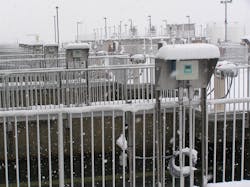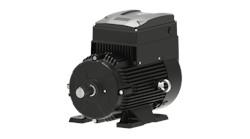Radar technology is often viewed as the "best" method of level measurement, but this is not always true in the water industry. Although radar technology offers high performance and accuracy, in many water and wastewater applications non-contact level measurement using ultrasonic instruments (see Image 1) is an ideal choice because of its lower cost and application-specific benefits.
This article compares ultrasonic and radar sensors and provides situations in which ultrasonic instruments are a more effective choice.
Level measurements
Continuous level measurements and limit-level detection are needed in water and wastewater treatment plants from a process engineering, water management and safety perspective. Level monitoring and control are key factors in optimizing operation between influent flow to the plant and treatment processes and for calculating and controlling costs.
Because no single level technology exists that is suitable for all processes, each technology has its place depending on the process material, process conditions and environmental conditions. Installation options are also a consideration when selecting the technology that is the best fit. In many processes, multiple level technologies may perform equally well, leaving cost as a key consideration. Selecting the appropriate level technology for an application is critical for successful measurement, controlling the initial costs of the instruments and eliminating costs that may be associated with maintaining a less than ideal technology.
Ultrasonic versus radar
When continuous level measurement is required in a water or wastewater application, free-space radar and ultrasonic instruments are frequently used and offer advantages when compared to other technologies.
Ultrasonic sensors (see Image 2) use piezo crystals to generate a mechanical pulse that is launched from the sensor membrane. This sound wave reflects off the surface of the process medium because of a change in density between air and the medium. The reflected pulse is then received at the sensor membrane. The time of flight between transmission and reception of the reflected pulse (echo) corresponds directly to the distance between the sensor membrane and the medium’s surface. Because an empty calibration distance (the distance from the sensor membrane to the bottom of the vessel) is programmed upon commissioning the sensor, the instrument can report the actual level by subtracting the measured distance from the empty calibration distance.
Image 2. To determine tank level, an ultrasonic sensor sends a sonic pulse to the surface of a liquid or solid and measures the time of flight for the reflected signal.
An ultrasonic pulse (a mechanical sound wave) requires air as a transmission medium, and ultrasonic instruments operate based on the speed of sound in the air. For this reason, ultrasonic sensors cannot be used for level measurement in a vacuum. If the space between the sensor membrane and the surface of the process contains other gases, such as nitrogen, methane or carbon dioxide, the velocity of sound will be different and will result in large measuring errors.
Free space radar (see Image 3) operates on the same time of flight principle. However, radar uses high-frequency microwaves emitted from an antenna. Rather than reflecting based on a change in density as sound waves do, microwaves reflect based on a change in the dielectric constant of the process medium. Since microwaves are electromagnetic and do not require air as a transmission medium, radar is well-suited for use in a vacuum or when gases other than air occupy the empty space.
Image 3. A radar instrument sends a microwave to the surface of a liquid or solid, and measures the time of flight for the reflected signal to determine level.
Ultrasonic applications
Many level applications —such as wet wells, rainwater basins and wastewater chemicals (without vapor) — are ideal for ultrasonic sensor use. Ultrasonic sensors offer flexible installation options and require minimal maintenance. Some users moved away from ultrasonic sensors because they historically provided erroneous measurements caused by condensation. However, an ultrasonic sensor equipped with automatic self-cleaning eliminates errors caused by condensation.
By monitoring the amplitude of the signal at the sensor membrane, condensation is detected by a dampening of the amplitude. The unit automatically increases frequency to the piezo crystals, creating a self-cleaning effect and ensuring that the sensor membrane is free from the dampening effects caused by condensation or buildup. This feature allows ultrasonic technology to be used without condensation concerns.
Measuring inlet flow with a level sensor in an open channel weir or flume is a primary measurement in a wastewater plant. A level sensor is used to measure the level in a flume or weir and converts the level to a flow rate using a Q-H curve (flow versus head). Many ultrasonic sensors contain preprogrammed Q-H curves for a variety of flumes and weirs. Alternately, many ultrasonic instruments allow for manual entry of a table for non-standard flumes or weirs. The measurement accuracy of an ultrasonic sensor is sufficient for open-channel flow measurement, eliminating the added cost of a radar device.
Rainwater basins (see Figure 1) are used to prevent the overloading of wastewater plants. In these buffer basins, measuring the level in the basin and the volume of overflow into the drainage channel is necessary. Some ultrasonic instruments can measure both variables simultaneously with only one sensor in the basin connected to a level transmitter that can be mounted up to 1,000 feet away from the sensor.
Figure 1. Some ultrasonic sensors can measure level in a rainwater basin and the volume of water diverted to the outfall.
Ultrasonic sensors can be installed in tight places because they are relatively small and can be mounted directly to a ceiling (see Image 4). When used with a flooding protection tube, an ultrasonic sensor can ensure that a high measurement is indicated even if the sensor is flooded and under water. In outdoor installations where temperatures can drop below freezing, ultrasonic sensors should be ordered with integral heaters to prevent ice formation, ensuring reliable measurements year-round.
Image 4. Many ultrasonic level sensors are small enough to mount directly onto the roof or ceiling.
Cleaning mechanical bar screens is most efficient when performed on an as-needed basis rather than on a timer or when an overload condition occurs. To achieve this, two ultrasonic sensors can be installed — one upstream of the bar screen and one downstream from it — to measure the difference in level (see Figure 2). When the bar screen is clean, the levels will be nearly equal. As the bar screen traps solids and debris, flow through the bar screen is restricted and the upstream level will rise higher than the downstream level. The levels can be monitored by a transmitter, which can analyze the levels and control the bar screen cleaning process.
Figure 2. Some ultrasonic sensors monitor levels on both sides of a bar screen.
Radar applications
In some wastewater applications, radar is clearly a better option than ultrasonic sensors. Because radar uses microwaves, the gas in the head space is irrelevant. While radar is certainly not a "silver bullet" for use in foam, it performs better than ultrasonic when foam accumulates on the surface.
Sludge digesters are common in wastewater treatment. Sludge digestion is a bacterial process that can be conducted either in the presence of oxygen (aerobic digestion) or the absence of oxygen (anaerobic digestion). In both processes, the sludge is converted from complex proteins and sugars into more simple compounds, such as water and carbon dioxide or methane. These digesters often generate foam and contain gases that would rule out an ultrasonic sensor’s use. Radar works well in this application.
Many chemicals are required in wastewater treatment. Because a level measurement using ultrasonic sensors is based on the speed of sound in air, if the empty space in the tank has anything other than air, large measurement errors can occur. For example, the speed of sound in chlorine is around 38 percent slower than in air. As a result, a level may be reported that is 38 percent lower than the actual level. The speed of sound in nitrogen is approximately 11 percent faster than in air, which could indicate a level 11 percent higher than the actual level. In these tanks, radar is a better option than ultrasonic.
Summary
Radar level measurement is an excellent, high-performing choice for many applications, but it may not be the best choice in wastewater applications. Some recently developed ultrasonic level instruments have features included specifically for the wastewater industry. Ultrasonic level instruments can be a cost-effective and beneficial part of an efficient and safe wastewater treatment plant and should be considered when selecting instruments.







